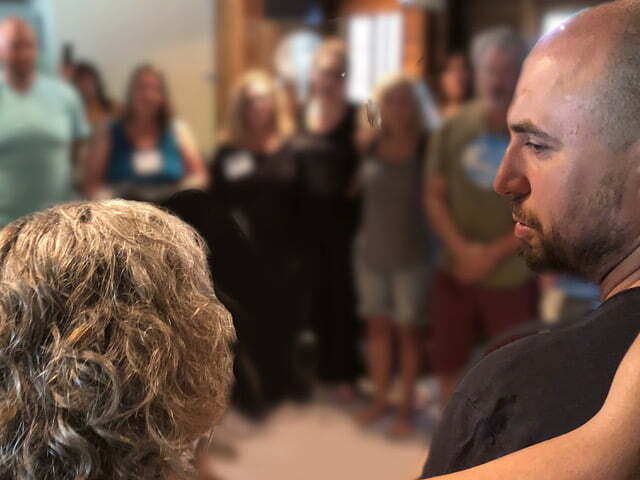Most workplace problems are relational problems, and are at the root of staff morale issues, absenteeism, and low productivity. We want to feel passionate about our work, because we recognize how much time and energy we will spend in the workplace. However, as personal investment in the workplace increases, so does vulnerability, because when something is important we feel vulnerable. This can happen when we believe in what we are doing, it can happen because the people we work with become important, and it can happen just because of the amount of time we end up spending at the workplace, as routine integrates more deeply into our lives.
As vulnerability increases, so do organizational/relational problems, because we don’t know how to handle our own vulnerability. We feel vulnerable, and react to our own vulnerability in predictable ways, by hiding, pretending, strategizing and defending. This vulnerability is connected to emotional unfinished business from our past.
We are born into a family, often to well-intentioned and imperfect parents who were raised by well-intentioned and imperfect parents. At some point in time, something painful happens, often with the people who love us, and this ‘happening’ lays the foundation for all the difficulties we end up having in relationship with others. We develop a ‘basement’ in our psyches, which exists at an emotional rather than an intellectual level, because our primary operating system when we are young is emotional. We take on ‘suspicions’ about ourselves, fears that we are not good enough, unloveable etc. and develop masks and strategies to defend against these fears about who we really are.
These strategies end up creating the problematic dynamics that undermine an organizations overt power structure and goals. The following 5 skills offer a way to address vulnerability in the workplace in an emotionally responsible way. People and organizations thrive in a positive, honest, supportive atmosphere.
Skill #1: Containment
Containment refers to your ability to feel, and particularly to feel uncomfortable emotions, before you act. When something happens that triggers us, too often we react, because that trigger seems to just ‘pull’ that reactive behaviour from us. We have to learn to create a space between the triggering event and our reaction to it. In our work, we often advise people to ‘sit in your anxiety’, meaning feel it rather than try to fix it. It is scary to feel those uncomfortable feelings because we are so convinced that something bad is happening. We are convinced because in our past something bad did happen, and so now we react to our own fear instead of proactively addressing whatever is actually happening in the present.
The practice of containment, of not reacting, requires emotional awareness as its foundation. There are any number of simple emotional awareness meditations on the internet which assist in becoming aware of the felt sensation of a given emotion. The more practice you have in simply allowing your felt experience, the less these emotions will drive you in your daily life. You will recognize them when they occur, instead of having them set off an internal alarm that then activates a patterned behaviour. The act of labelling a feeling decreases the intensity of it, allowing you to do something proactive rather than reactive, which leads us to our next skill.
Skill #2: Reflect Vs. Reload
As we move through life, we constantly encounter situations that fire off a predictable reaction: we are ‘triggered’. We all have our unique triggers, because we all have our unique life experience, and only those that resemble the difficult aspects of our past in some way will be a ‘trigger’. When a trigger activates a particular feeling, and you are able to contain your experience within, it is an opportunity to reflect (instead of reloading your familiar strategies). The feelings that surface in a moment when you are triggered are a window to the past. In those moments, someone is knocking on the door to the basement of your psyche.
When we are triggered, we are using the current situation to prove our fears. This doesn’t mean that difficult and upsetting things don’t happen, of course they do. But if the current situation is a spark, our past is like gasoline that we throw on top of that spark. Human beings are capable of handling even the most difficult losses and events if we resist the temptation to draw negative, destructive conclusions about them. The point in reflecting is to turn your focus inside, rather than continuing to focus on what is happening outside of self as an explanation for your pain.
When we contain our feelings and reflect, we have a chance to ask ourselves some very important questions such as:
- What do I fear is happening?
- Therefore, what do I fear this situation means about me? Is my fear true? (NO!)
- What can I take responsibility for?
- Conversely, what will I not take responsibility for?
Skill # 3: Vulnerable Communication
Vulnerable communication is the art of telling the truth without blame. Rather than hide, pretend, defend or offend, the goal is to communicate honestly what is happening inside. Vulnerability invites connection, because when we are legitimately vulnerable we are being real. What we are believing in our vulnerability may be mistaken (when revealing our fears about self), but it is attractive because even so others are seeing your real, unhidden self. We will never be attracted to masks and strategies in the same way. Vulnerability is key to real, healthy relationships.
The degree to which you bare your soul to any one human being is a judgment call, but we all need relationships in which we can let our most tender parts be seen. It isn’t healthy to ‘overshare’ in a relationship that has not earned your trust, and at the same time trust is a process that evolves out of risking vulnerability. Relationships develop into vessels of transformation when one person takes a vulnerable step, is met by the other who also takes a step, and so on until a bond of trust is formed.
Healthy, emotionally responsible, vulnerable communication exists along a spectrum that starts with stating a relationship intention, moves to taking accountability and ends with transparency. The first two of these can be done in any relationship, including at work.
To find out the prerequisites and more, tune into Part 2 of this post.

Catherine and Duane O’Kane are the founders of Clearmind international. It is Duane’s passion and belief that all that we strive for is held hostage in the middle of every moment, every relationship and every situation. Clearmind was birthed from these principles and continues to evolve. If you ask Catherine how Clearmind began, she says our mission statement “Love out Loud” sums it all up. Anyone can feel wonderfully inspired, but if it isn’t acted upon, it doesn’t have a life.

